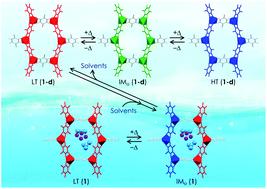Chameleonic layered metal–organic frameworks with variable charge-ordered states triggered by temperature and guest molecules†
Abstract
Molecular materials whose electronic states are multiply varied depending on external stimuli are among the most promising targets for the development of multiply accessible molecular switches. Here, we report a honeycomb layer composed of tetraoxolene-bridged iron (Fe) subunits whose charge-ordered states are multiply variable via thermal treatments and solvation/desolvation with the crystallinity intact. The compound is (NPr4)2[Fe2(Cl2An)3] (1-d; NPr4+ = tetra-n-propylammonium; Cl2An2− = 2,5-dichloro-3,6-dihydroxo-1,4-benzoquinonate), which possesses three charge-ordered states: a low-temperature (LT) phase [(Fe3+)2(Cl2An2−)(Cl2An˙3−)2]2−; an intermediate (IM) phase [(Fe2.5+)2(Cl2An2−)(Cl2An2.5−)2]2−; and a high-temperature (HT) phase [(Fe2+)2(Cl2An2−)3]2− that varies according to temperature. In addition, the LT phase of 1-d is reversibly changeable to another IM phase in its solvated compound 1via a solvation/desolvation process at room temperature. This example demonstrates a new multiple-switching system based on electron transfer and host–guest chemistry in a charge-flexible metal–organic framework.



 Please wait while we load your content...
Please wait while we load your content...